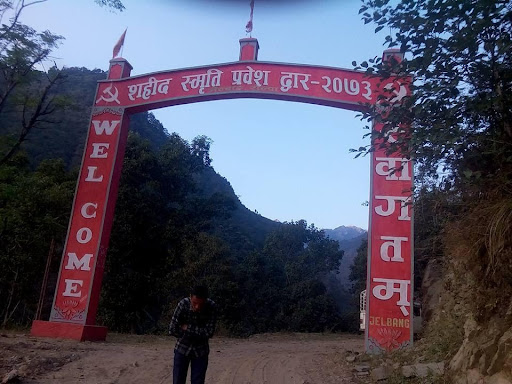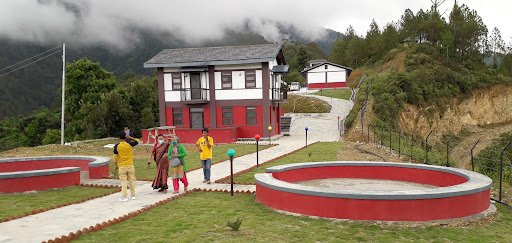Nepal’s ‘war tourism’ is a scam
After the decade-long Maoist conflict ended in 2006, ex-guerrilla commanders and local governments here saw great potential for ‘war tourism’ in the revolutionary heartland.
These craggy and remote mountains of mid-western Nepal were where the Maoists launched their armed struggle in February 1996, and many obscure villages like Holeri, Khara and Gam became household words because of the famous battle that raged there.
More than 15 years after the war ended, the former guerrillas have been in and out of government many times and have earmarked a budget every year to take the region ‘from Maoism to tourism’.
The idea is to use the historical memory of the conflict to honour the sacrifices of those who died in the insurgency, generate income from trekking tourism, and create local jobs.
In the past 15 years, the central government alone has spent Rs500 million to promote ‘war tourism’. But the money has mostly been doled out to the cadre of the Maoist Centre party, which is once again a member of the coalition government in Kathmandu now.
Rolpa today is as neglected as ever, former guerrilla commanders who are in government have not done much to provide health and education, or lift the living standards of the people in whose name they fought a war of liberation.
An example of the enormous waste of money is a safe house in Rolpa in which Maoist Supreme Commander Prachanda (Pushpa Kamal Dahal) once sought shelter in 2001 during the conflict.
In 2019, the local infrastructure initiative spent Rs10 million to renovate this house ostensibly to turn it into a museum. The mud and thatch two-storey house belongs to the brother of Maoist leader Jayapuri Gharti, and another of her brothers was made the chair of the project. The money was used to purchase the house and build a metal structure to shelter the shelter from the elements.
“All that money was spent for nothing,” says Anil KC, a Maoist from the Biplav faction. “They brought some journalists here and took some pictures. I don’t think any tourists have come this way.”
Of the 17,000 people who were killed in the conflict, nearly 1,000 were from Rolpa district. And 35 of the 1,380 people still listed as missing are also from the district in which the Maoists launched their armed struggle on 13 February 1996 with an attack on the Holeri police post.

Right after the conflict ended, the Ministry of Peace in Kathmandu allocated Rs1.1 million to build a ‘martyrs gate’ in Holeri that would also commemorate the first Maoist attack. There is no sign of the gate today.
“There was a gate here, but since so much of the money was embezzled during its construction, those involved demolished it, saying they needed to widen a road,” says the mayor of Runtogadi Balaram Buda.
In 2011, the district administration allocated Rs 17 million for nine projects to develop trekking infrastructure in Rolpa. After the 2017 election, municipal, provincial and federal governments have paid out more money to build rest houses, repair trails and construct view towers along the paths that the guerrillas used.
Similarly, the Peace Ministry had doled out Rs1.86 million seven years ago to construct a memorial to Maoist commander Khim Thapa in Sulichaur. It was never built.

“I remember before I was elected, some bulldozers were levelling the site, but I have no idea why the park was never built,” says ward chair Ganj Chhetri.
In April 2001, 44 Maoists were killed in a fierce battle in Pategumchal of Rolpa. Seven years ago, the Ministry of Peace allocated Rs1.55 million to build a memorial column at the site of the battle.
A cement shed and latrine were built, but they are not usable. After pressure from local people, a committee headed by Nar Bahadur Pun finally built a makeshift gate.
The village of Gam of Rolpa district made national headlines in 2002 after a fierce battle that killed 35 Maoists and left 106 police and civil servants dead. There is a ‘martyrs’ pillar’ to commemorate the battle, but it looks abandoned.
“All they did was steal the money meant for those who died, they just built this to show they did something,” says local Deu Gharti Magar.
The municipality got another Rs3.2 million to build a ‘martyrs’ memorial peace park’ under the chairmanship of Maoist Centre leader Ramesh Buda. It was also never built. Local Maoist leaders are uncomfortable when asked about where all the money went.
Another Rs3.2 million was given to a committee to build a martyrs’ memorial park in Jankot. Some of it was used to buy the land, but nothing was built, and it looks like the rest of the money has vanished.

Despite questions about how building martyrs’ gates and pillars will help promote ‘war tourism’, budget outlays have continued to local committees for projects that lack any utility. And even the money set aside to build those memorials is misused, or simply stolen.
In Dubi Danda of Rolpa, Rs2.5 million was given between 2011-2015 to build a park, but all that was done was construct a makeshift shed and the site levelled to make a helipad. It is the same story in Gangadev municipality – Rs3.2 million was given to a local committee that hired a bulldozer to clear the slope, and nothing was built.
In 1999, police captured 11 members of a Maoist cultural troupe in Bhawang, executed them and burnt the bodies. The Peace Ministry allocated Rs2.5 million to build a memorial for them, but today there is just a shed ringed with barbed wire at the site where the guerrillas’ bodies were set alight.

In numerous other places, money has been given to local Maoist cadres to build parks, but aside from a memorial in Thawang, either nothing was ever built or whatever was constructed has no tangible value to the public. Altogether Rs12 million was given for park projects in Iribang, Gajul and Thawang.
“They have exploited our grief and bereavement to enrich themselves,” says Dev Bahadur Oli, whose brother Sundar was killed by the security forces in 2002. “The money is just a handout to the party cadre to rent dozers, it is not transparent at all.”
Rolpa ranks 67th out of Nepal’s 77 districts in the Human Development Index (HDI). The district needs better schools and more hospitals, roads and bridges need to be upgraded, and people who lost their jobs during the pandemic need help.
Yet, all three levels of government keep wasting money on physical monuments that have no public service function – even if they are built.
Khem Buda Magar, who headed the now-defunct District Peace Committee, says it is not just the misuse of state resources to build so-called parks and memorials, but such projects have failed to honour those who died or were disappeared, and their relatives feel they are also forgotten.
Rolpa’s elected representatives see much potential in trekking as tourism rebounds after the Covid-19 pandemic. In fact, all local governments have put trekking tourism top on the list of priorities.
In the 2018-19 fiscal year, Madi, Paribartan and Thawang municipality spent altogether Rs4.5 million for so-called ‘tourism development’. In addition, Lumbini Province in this year’s budget allocated Rs20 million for tourism infrastructure in Thawang.

Even the Ministry of Tourism and Civil Aviation under the federal government has granted Rs7.5 million for the ‘Guerrilla Trekking Trail’ along the Jaljala mountain. Of this, only a 1.8km path has been built by a local committee in Jelbang.
Rs4 million was also given to Thawang for a ‘Yarsa Trekking Trail’ that follows the paths used by yarsagumba pickers. The municipality only built a 2.5km trail with the money, but it is not used much, says Thawang resident Sri Kumari Roka.
“It is a trail to nowhere, why should anyone walk on it?” she asks.

Six of Rolpa’s local governments set aside Rs7.4 million last fiscal year for ‘war tourism’, and Lumbini Province allocated Rs5 million for the purpose.
The whole town of Jelbang was supposed to be turned into a ‘model village’ to honour the 73 Maoists who were killed there in 2001, by helping their relatives. The Peace Ministry even granted Rs2.8 million for the purpose. But it was all spent on road repairs, and the ward chair says that was a joint decision.
“The money that came to build model villages ended up giving some Maoist leaders and cadre a model lifestyle,” says local resident Bharat Roka mockingly.
A former Maoist camp supervised by the United Nations Mission in Nepal (UNMIN) in Triveni of Rolpa is being turned into a museum at a cost of Rs9 million. The project is headed by a local leader of the Maoist Centre Amar Dangi, who himself is related to Lumbini Province Chief Minister Kul Prasad KC.
Another building in Thawang for a ‘Martyr Foundation’ was allocated Rs6.5 million, but it had been lying in its abandoned state until it was converted last year into an isolation centre for Covid-19 patients.


Much of the rest of the money allocated for ‘war tourism’ is now being spent on building concrete view towers on mountain tops in Rolpa. Critics have questioned why mountain tops that are already very high need to be a few metres higher with these wasteful symbols.
One such mountain is the 2,055m high Chuche Peak on top of which the local municipality is building a 10-floor 115m view tower at a cost of Rs48 million. Another view tower is sprouting near Holeri, the cradle of the Maoist revolution.
All this construction is happening in a district where there are 200 government schools with nearly 70,000 students, but very few teachers. At Sunchahari municipality there are 5,000 students, the school buildings are rudimentary, and there is not a single secondary school teacher.
The doctor-patient ratio in Rolpa is 1:25,000, and families have to walk for days just to reach a health post even for simple treatments for relatives.
Yet, all this does not seem to concern any of the three levels of government that have spent Rs30 million just on 90 temples in the district.
One of the more useful projects has been the establishment of ethnic museums, with ones for Gurung, Magar and Dalit peoples. The Gurung Museum has exhibits and a homestay.

Erstwhile Finance Minister Barsha Man Pun, who was once a guerrilla commander, inaugurated an ‘Information Centre’ and an ‘indigenous museum’ for the war tourism project 12km from the district capital of Libang. No one is using the building, and it is falling apart.
The war tourism initiative was launched without any study or business plan. It has not been promoted adequately, and has just been an excuse to distribute money to Maoist cadre, says Amar Singh Pun, a former minister from Rolpa.
He adds: “This has been a colossal waste of money, a pretext for cash handouts to party loyalists.”
This report was prepared by Mahesh Neupane for the Centre for Investigative Journalism Nepal. The Nepali original can be found here.




